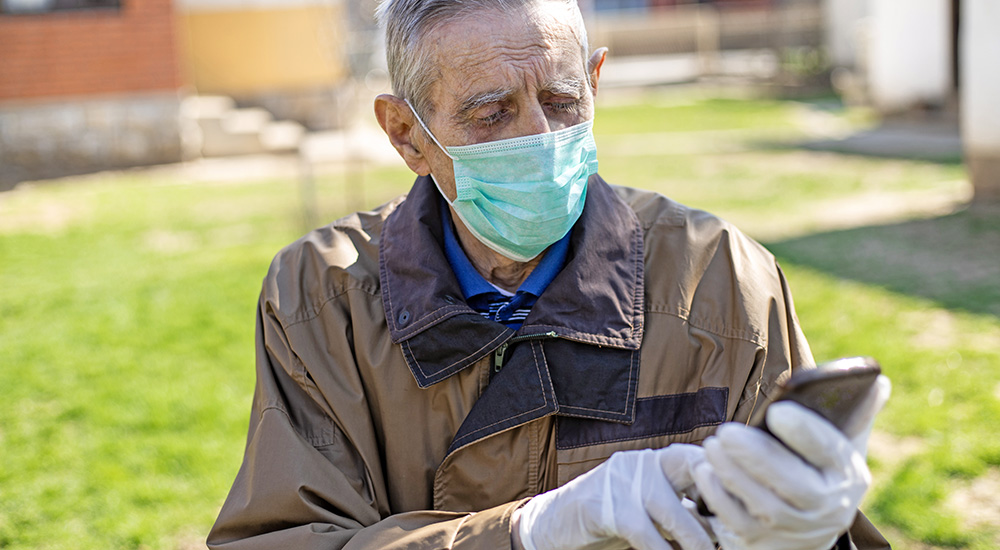At the beginning of the COVID-19 pandemic in 2020, medical centers across the globe worked tirelessly to revamp processes and protocols to ensure the safety of both patients and facility staff. Telehealth is one of those options.
At the Northport VA Medical Center in New York, one new program ensured that Veterans who tested positive for COVID-19 at discharge went home with the equipment they needed to watch their symptoms at home.
“A unique challenge of COVID was that often someone would come to the hospital, be well enough to be discharged and then get worse,” said Dr. Peter Avvento, internal medicine. “Home monitoring was important during the height of COVID because four to five days into a patient’s diagnosis, they would have respiratory symptoms and need more care.”
Veterans who needed inpatient or emergency care at Northport VA were given a thermometer and pulse oximeter before leaving the facility. Veterans were taught how to use the equipment to check their temperature, breathing and oxygen levels. This enabled them to establish a base measurement of their vitals to watch for any changes.
Veterans submit vital signs daily
Once the Veterans went home from the hospital, their VA care teams used Home Telehealth to continue monitoring their COVID-19 symptoms. Every day, their Home Telehealth coordinators required them to submit their vital signs and answer questions related to COVID-19. The coordinators then reviewed the Veterans’ daily readings and watched for any alarming changes.
The program gave anxious Veterans the reassurance they needed, especially when COVID-19 was new and a lot about the disease was unknown.
At first, Northport VA mailed home monitoring equipment to Veterans. But that could result in significant delays. The facility instead stocked equipment to give to Veterans on-site and providers taught the Veterans how to use the equipment.
Stocked equipment in each COVID unit
But this solution came with its own challenges. Namely, providers couldn’t leave their units without the risk of spreading COVID-19 across the facility.
To address this problem, Avvento and nurse Jasmine Pace, Home Telehealth care coordinator, worked with their colleagues to stock thermometers and pulse oximeters in each unit of the facility that treated COVID-19 patients. This ensured that all Veterans received the equipment at discharge, and it reduced the spread of COVID-19 across units.
Avvento and Pace held a staff meeting every day to increase communication across all departments. At these meetings, they would share updates on equipment stock in each unit and discuss Veterans being discharged that day and what equipment they would need.
“I could speak with a provider during the meeting and remind them to discharge their patient with a thermometer and pulse oximeter and make sure they put in for a telehealth consult,” Pace said.
The meetings were also essential to keeping a rotating team of staff informed and connected.
Expanding COVID-19 telehealth operations
As part of the new program, the Home Telehealth team expanded its operations from five to seven days a week to provide daily check-in calls for Veterans enrolled in telehealth. The daily phone call required Veterans to report their temperature and oxygen levels.
If their numbers fell out of range, the Veteran’s Home Telehealth coordinator would contact the Veteran right away to further assess the situation. If a Veteran didn’t respond or never reported their vitals, a Home Telehealth coordinator would also follow up.
“We monitored our COVID patients daily,” said Pace. “If they didn’t submit their results by a certain time, we had to track them down and call their emergency contacts. If we couldn’t contact them, we would call the police to do a wellness check on them.”
Providing Veterans with more than just equipment
Along with ensuring the health and safety of Veterans after they were discharged, the new program also strengthened the trust between Veterans and their providers.
“It allowed the treating team to show that we care about the patient, both now and in the future,” Avvento said. “Most of our patients had a lot of anxiety about going home with COVID since there was so much unknown. Having the treating team go over the devices with patients and talk about warning signs before discharge was so important in alleviating this anxiety.”
The facility still uses this protocol for COVID-19 patients at discharge. As a result of the efforts of the facility’s providers, many more Veterans have turned to telehealth as part of their VA care.
“We converted a lot of patients to regular telehealth patients,” said Avvento. “They still use it today because they always feel like they have their provider watching over them.”
The increased use of telehealth has helped Northport VA continue to focus on patient safety and care for the best health outcomes.
To learn more about the benefits of VA telehealth, visit VA Telehealth Services website.
Topics in this story
More Stories
Study underscores important role COVID vaccination can have in protecting Veterans from infection and reducing long-term health consequences
Columbia VA’s robotic surgery teams completed their 800th robotic surgery and are on schedule to hit 1,000 by the end of the year.
In a decentralized clinical trial, Veterans can participate from their own homes or local VA instead of having to travel to a research site.






